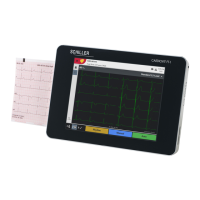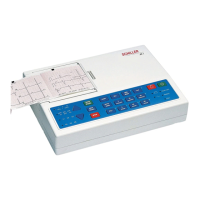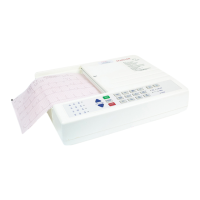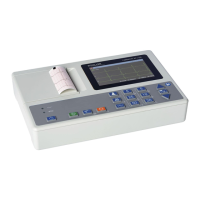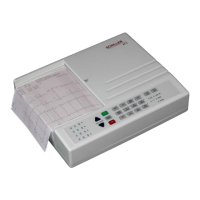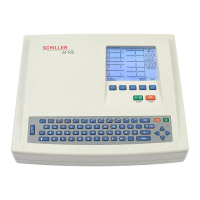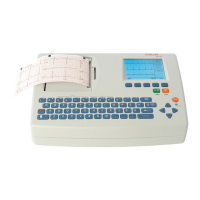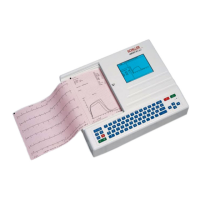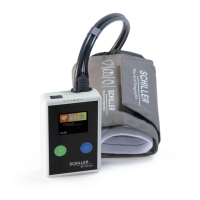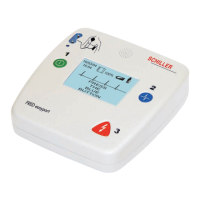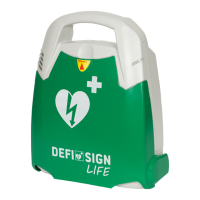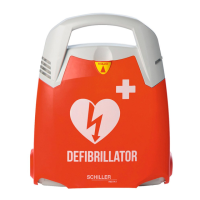Do you have a question about the Schiller CARDIOVIT CS-104 and is the answer not in the manual?
Defines the intended use of the CARDIOVIT CS-104 system for cardiological diagnosis in adult and pediatric patients.
Specifies the CARDIOVIT CS-104's use as a 12-lead ECG device for acquiring and analyzing ECG signals.
Lists optional features available with the CARDIOVIT CS-104, such as Exercise ECG and Spirometry.
Describes the intended users of the CARDIOVIT CS-104, primarily trained medical professionals.
Specifies the target patient population for the CARDIOVIT CS-104, including adults and pediatric patients.
Provides a general overview of the CARDIOVIT CS-104's capabilities as a 12-lead ECG device.
Details the different configurations available for the CARDIOVIT CS-104 system.
Lists the various features and optional modules that can be integrated with the CARDIOVIT CS-104.
Outlines the procedure for installing the CARDIOVIT CS-104 system, typically performed by SCHILLER staff.
Explains the networking capabilities and SCHILLER Server integration of the CARDIOVIT CS-104.
Introduces the three available ECG recorders compatible with the CARDIOVIT CS-104.
Describes how to turn the CARDIOVIT CS-104 system on and off, and launch the software.
Details the power supply options and requirements for the CARDIOVIT CS-104 and its accessories.
Specifies the recommended operating environment and location for the CARDIOVIT CS-104.
Explains how to lock the wheels of the CARDIOVIT CS-104 trolley for stability.
Refers to system and ECG settings defined in the System Settings section.
Details the login procedure for accessing the CARDIOVIT CS-104 software, including user name and password entry.
Explains the workflow model and navigation through the main menu and screens of the software.
Illustrates and describes the CARDIOVIT CS-104 software's home screen layout.
Details the general layout of screens, including side bar and bottom icons, with user-configurable elements.
Guides users on how to select and display the connected recording device.
Explains how to check and understand the connection status with the SCHILLER Server.
Describes how to view and manage recorded ECG and Spiro data.
Covers customizing the display and defining icons for side and bottom action bars.
Explains how to search for patients and recordings using various criteria.
Details how to enter, edit, and manage patient information within the system.
Describes how to add or change recording-specific patient data and additional information.
Provides detailed instructions and diagrams for correct electrode placement on the patient.
Guides users on how to access the ECG recording screens.
Explains the hookup screen, electrode placement verification, and signal quality check.
Details how the system checks electrode connection, resistance, and quality indication.
Covers selecting standard or Cabrera lead sequences for ECG display and analysis.
Describes how to adjust the display layout, speed, and amplitude of the ECG trace.
Explains the function and indication of pacemaker pulse detection during ECG recording.
Details the use of filters to reduce muscle artefact and improve ECG signal quality.
Describes how to enter or measure blood pressure during ECG recordings.
Explains the process of saving an ECG recording.
Guides users on how to discard an ECG recording without saving it.
Outlines the step-by-step procedure for performing a resting ECG recording.
Explains the ETM Sport option for diagnosing abnormalities in athletes during resting ECG.
Details the step-by-step procedure for performing a rhythm ECG recording.
Describes the Arrhythmia option for displaying ventricular ectopic beat rate during rhythm recordings.
Explains how to register manual events during a rhythm ECG recording.
Covers saving or discarding a rhythm ECG recording after analysis.
Provides essential safety precautions to be followed during exercise ECG testing.
Explains the function and use of the emergency stop during exercise tests.
Lists critical settings to verify before initiating an exercise ECG test.
Outlines the step-by-step procedure for conducting an exercise ECG test.
Describes the interface and functions available during an ongoing exercise ECG test.
Explains the procedures for ending an exercise ECG test, including recovery stages.
Covers general settings and options for analyzing ECG recordings.
Explains how to save changes made after editing an ECG recording.
Details how to print ECG recordings or generate PDF files.
Describes the process of direct printing or generating PDF files from recordings.
Guides users on how to reject recordings due to poor quality.
Covers the various views and functions available for analyzing resting ECG recordings.
Explains the different data views and functions for analyzing resting ECGs.
Details the ECG filter settings for reducing muscle artefact.
Describes how to perform and display ECG measurements.
Explains how to use the zoom function to view specific sections of the ECG trace.
Covers adjusting the display of amplitude and speed of the ECG waveform.
Explains how to change the displayed rhythm leads in different views.
Details the display of averaged ECG measurements in a tabular format.
Covers measuring and editing RR intervals and calculating heart rate.
Explains how to adjust measurement points for reinterpretation.
Details the display and adjustment of measurement intervals and heart rate.
Describes how to enter, validate, and edit ECG interpretations.
Explains the ETM Sport option for athlete-specific ECG interpretation.
Details the criteria and measurements for Left Ventricular Hypertrophy (LVH).
Covers the display and analysis of vector cardiograms.
Explains how to perform a full visual comparison of ECG recordings.
Describes the different views for displaying rhythm ECG recordings.
Explains the full disclosure view for analyzing rhythm ECGs.
Details how events are indicated and added during rhythm recordings.
Covers viewing all events associated with a rhythm recording.
Provides a summary of the exercise ECG test results and parameters.
Guides on editing results in the exercise ECG step table.
Explains how to adjust the ST measuring point and its effect on analysis.
Describes the average view for displaying complexes from different stages.
Explains the continuous rhythm view for displaying rhythm ECGs.
Details the full disclosure view for rhythm ECGs.
Describes the step view for displaying rhythm ECGs by stage.
Covers displaying averaged complexes for each step of the test.
Explains how to view averaged measurements for each stage.
Details the ST measurements for every lead and step in a table format.
Describes the graphical display of ST measurements over time.
Defines the concept and purpose of a worklist in managing work requests.
Describes the worklist screen interface and how to access it.
Explains how to download work items from a worklist.
Details the information provided for each work item in the worklist.
Guides users on how to perform a worklist item, including carrying out the recording.
Details the process of importing recordings into the system.
Explains how to export recordings from the system.
Describes how to display log files related to export operations.
Provides an overview of the system settings available in the CARDIOVIT CS-104.
Explains how to search for specific settings within the system settings menu.
Defines the different types of settings (System, Global, Device, User).
Describes how to apply user or device settings to all users.
Details the procedure for changing the user password for security.
Explains how to import and export system settings for configuration management.
Covers general system settings related to station, font size, and screen resolution.
Defines settings for the device ID and department/institute.
Allows adjustment of the display font size for better readability.
Covers settings for screen resolution and calibration.
Defines the screen layout options, including full screen and control bars.
Explains how to enable a recording selector for managing multiple patient recordings.
Sets the initial activity or screen displayed upon startup.
Allows defining custom fields for additional patient data.
Allows defining medication options for selection in patient data.
Enables simulation mode for displaying fake data for demonstration.
Configures how the ECG is displayed on the screen, including colours and thickness.
Covers regional settings like date/time format, language, and units.
Sets the format for displaying dates and times.
Allows selection of system language and country preferences.
Sets system units for weight, length, speed, etc.
Defines the format and generation method for patient IDs.
Covers settings related to network connectivity and server communication.
Details the configuration for connecting to the SCHILLER Server.
Explains the settings for the SCHILLER Update Server and program updates.
Covers settings for importing and exporting data using GDT, SEMA2, and SEMA XML.
Details the interface and mode for importing data.
Details the interface and options for exporting data.
Covers specific settings for GDT and SEMA2 interfaces.
Covers general, default, and custom acronyms for ECG interpretation.
General settings for attaching interpretations and using automatic interpretation.
Allows adding user-defined interpretation acronyms for various recording types.
Enables the use of custom acronyms for advanced interpretation options.
Allows creation of acronym templates for comprehensive interpretation options.
Covers quick search fields and limiting search results.
Details the fields available for quick searching patients or recordings.
Sets the maximum number of results displayed in search functions.
Covers security settings like auto user logout and single sign-on.
Configures automatic program locking after a period of user inactivity.
Enables single sign-on for simplified user access.
Displays information about active options and license keys.
Configures data included in reports, printouts, and PDF files.
Sets company logo, information, rhythm mode, and QTC calculation.
Defines the information included in the report header.
Specifies the printer settings for reports.
Configures PDF export path, file name, and conformance.
Selects available formats for reports and printouts.
Allows combining multiple report formats into a single report.
General ECG settings for acquisition and view.
Sets lead sequence, rhythm leads, and coding.
Sets the mains supply frequency (50 Hz, 60 Hz, or off).
Configures filters to suppress disturbances and improve ECG signal quality.
Sets how the ECG is displayed during review, including grid and trace properties.
Configures settings for printing ECGs and generating PDF files.
Defines scale settings for rhythm and average complexes.
Sets default scales for amplitude and speed of rhythm and average complexes.
Defines settings for rhythm recordings, including length, scale, and events.
Sets the default duration for rhythm recordings.
Sets scale parameters for rhythm ECGs, similar to resting ECG.
Defines wording for manual events in rhythm recordings.
Defines settings for exercise ECG, including ST trend, averages, recorder, and events.
General settings for ST trend graphs and average screen display.
Sets defaults for J-point and target heart rate calculation.
Sets default amplitude and speed scales for rhythm, continuous, and average views.
Defines wording for manual events in exercise ECGs.
Selects the ergo device (bike/treadmill) and COM port for connection.
Explains how to define privileges for different user roles.
Guides on adding new users, defining their roles and passwords.
Describes how to delete or edit existing user accounts.
Details the control button, power, and display functions of the MS-12 blue recorder.
Explains the functions of the MS-12 blue unit's control button.
Describes how to turn the MS-12 blue unit on.
Explains how to switch off the MS-12 blue unit.
Details switching off the unit via the main menu.
Describes switching off the unit from the ECG screen.
Covers the information and options shown on the MS-12 blue display.
Explains the electrode screen for checking connections and resistance.
Details the Bluetooth screen for managing wireless connections.
Guides on pairing the MS-12 blue unit with a PC via Bluetooth.
Explains how to remove previously paired Bluetooth connections.
Covers the power supply and battery information for the MS-12 blue unit.
Explains the battery status indicator and its meaning.
Details the procedure for replacing the batteries in the MS-12 blue unit.
Provides a detailed procedure for Bluetooth pairing with the MS-12 blue unit.
Guides on the steps to pair the MS-12 blue unit with a PC.
Details the function button and status indicators of the MS-12 USB recorder.
Explains the functionality of the MS-12 USB recorder's function button.
Provides information on the FT-1 Streamer, including its connection and operation.
Outlines preliminary checks and precautions before cleaning the device.
Recommends how often the recording device should be cleaned.
Provides detailed instructions and safety notes for cleaning and disinfecting the unit.
Details the procedure for cleaning cable assemblies.
Lists suitable and unsuitable cleaning materials and solutions.
Specifies the construction materials of the recorder for cleaning suitability.
Lists approved cleaning solutions for the device.
Lists materials and products that must not be used for cleaning.
Covers disinfection procedures and approved disinfectants.
Lists disinfectants approved for use on the unit.
Lists recommended disinfection products by SCHILLER.
Lists disinfectants that are not permitted for use on the unit.
Details the visual inspection steps for the device and accessories.
Explains how to perform a basic functional check of the system.
Covers safety and functional checks required for the system.
Specifies tests required after defibrillation.
Outlines procedures for decommissioning and storage of the equipment.
Provides guidance on the proper disposal of electronic parts and consumables.
Details disposal regulations for electronic components.
Covers disposal compliance for consumables.
Provides a template for unit maintenance reference sheets.
Details inspection steps for the six-month maintenance schedule.
Details inspection steps for the twenty-four-month maintenance schedule.
Lists common error messages and suggested actions for resolution.
Lists general accessories and disposables available for the system.
Lists patient cables and accessories for the MS-12 blue recorder.
Lists patient cables and accessories for the MS-12 USB recorder.
Lists accessories for the FT-1 streamer.
Details the technical specifications of the CARDIOVIT CS-104 system, including dimensions and computer components.
Lists the system requirements for PC-based installations of the software.
Specifies hardware and software requirements for the CARDIOVIT CS-104 PC installation.
Provides technical specifications for the available ECG recorders.
Details the technical specifications of the MS-12 USB recorder.
Details the technical specifications of the MS-12 blue recorder.
Refers to the FT-1 Streamer user guide for its technical specifications.
Lists general ECG specifications, including leads, frequency, and measurements.
Lists relevant safety and EMC standards complied with by the device.
Specifies environmental conditions for operation, storage, and transport.
Shows program details like version, release date, and license information.
Indicates where to find program history data, intended for service personnel.
Provides guidance on the disposal of the unit at the end of its lifecycle.
Advises on minimizing electromagnetic interference from other devices.
Covers installation procedures for PC-based systems using the MS-12 USB recorder.
Lists installation notes, screen resolution requirements, and licensing information.
Details the software installation process, including language and license configuration.
Explains how to connect exercise ECG and BP units, including serial adapter usage.
Provides steps to connect the USB-232 serial adapter for exercise ECG and BP units.
Describes the USB to RS-232 serial adapter used for connectivity.
Illustrates the overall connection overview for resting ECG and exercise testing.
| ECG Channels | 12-channel |
|---|---|
| Recording Speed | 5, 10, 25, 50 mm/s |
| Memory | Internal memory for up to 350 ECGs |
| Type | Resting ECG Device |
| Display | Color touchscreen |
| Input Impedance | >100 MOhm |
| Power Supply | AC adapter or rechargeable battery |
| Interpretation | SCHILLER ECG Interpretation |
| Connectivity | USB, LAN |
| Data Transmission | XML |
| Battery Life | Up to 4 hours |
